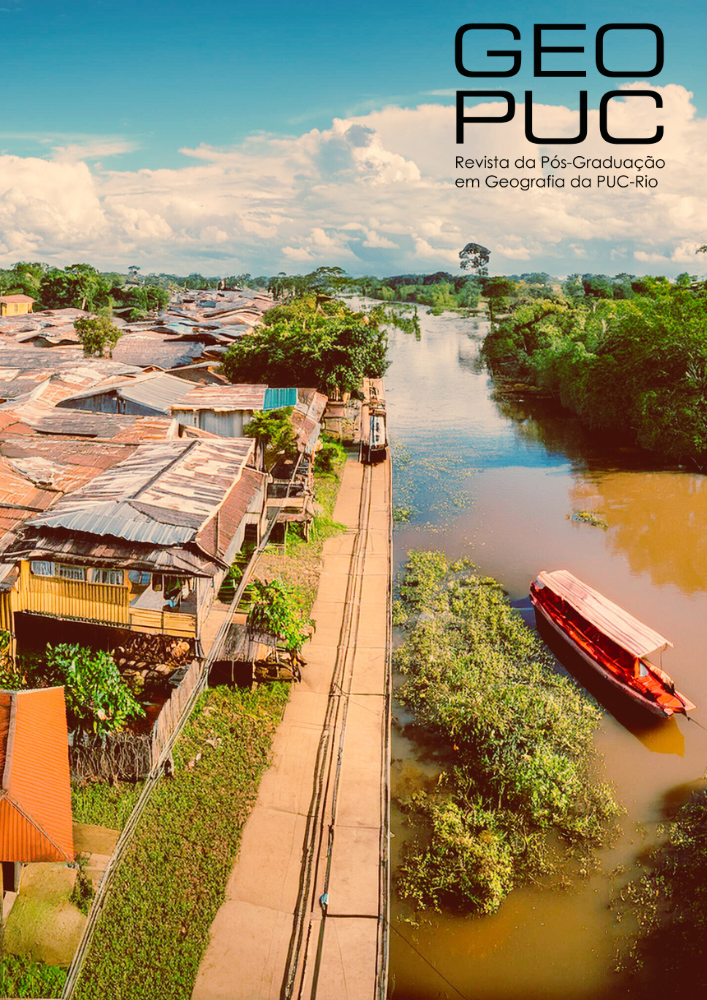The geography of the creative industry in Tocantins: regional analysis of recent years
DOI:
https://doi.org/10.64238/geopuc.2024.108Keywords:
Creative Industry, Economic and Regional Geography, TocantinsAbstract
This article analyzes the regional organization of the creative industry in the state of Tocantins in recent years. The study aims to understand how creative activities, based on creativity, knowledge, and innovation, are regionally distributed in the state, considering economic aspects related to labor and businesses. The central objective is to identify the geographic concentrations of these activities, analyze the growth dynamics, and highlight regional disparities that affect the distribution of these industries. The methodology employed involves the comparison of economic and employment data over a recent period, with an emphasis on three intermediate regions of the state: Palmas, Araguaína, and Gurupi. The results show a significant concentration of creative activities in the Palmas region, with varied growth in other regions, as well as highlighting wage disparities and the fragility of the creative labor market in the state.
Downloads
References
ADORNO, T. W; HORKHEIMER, M. Dialética do esclarecimento. Rio de Janeiro: Jorge Zahar, 1985.
ARAÚJO, Tania Bacelar de. Ensaios sobre o desenvolvimento brasileiro: heranças e urgências. Rio de Janeiro: Revan, 2000.
BECKER, H. S. Art Worlds. Berkeley, CA: University of California Press, 1982.
BENDASSOLLI, Pedro F; WOOD JR, Thomaz; KIRSCHBAUM, Charles; CUNHA, Miguel Pina.. Indústrias criativas: definição, limites e possibilidades. RAE. São Paulo. v.49, n1, jan/mar 2009.
BLYTHE, M. The work of art in the age of digital reproduction: the significance of the creative industries. JADE, v. 20, n. 2, p. 144-150, 2001.
CAVES, R. Creative Industries. Harvard: Harvard University Press, 2000.
DCMS (Department for Culture, Media and Sport). Creative industries mapping document. 2005. Disponível em: https://www.gov.uk/government/publications/creative-industries-mapping-documents-2001 . Acesso em 07.07.2024.
DCMS (Department for Culture, Media and Sport). Sectors Economic Estimates. 2016. Disponível em: https://www.gov.uk/government/statistics/dcms-sectors-economic-estimates-2016-trade. Acesso em 07.07.2024.
FARAONE, C. Territorial Challenges for Cultural and Creative Industries’ Contribution to Sustainable Innovation: Evidence from the Interreg Ita-Slo Project DIVA. Sustainability 2022.
FLORIDA, Richard. A ascensão da classe criativa. Porto Alegre, Rs: L&M, 2011.
GRISWOLD, W. The fabrication of meaning: literary interpretation in the United States, Great Britain, and the West Indies. American Journal of Sociology, v. 92, n. 5, p. 1077-1117, 1987.
HARTLEY, J. Creative Industries. London: Blackwell, 2005.
HARVEY, David. Condição Pós-Moderna. 13 ed. São Paulo: Edições Loyola. 128 2004.
HESMONDHALGH, D. The cultural industries. London: Sage, 2002.
HOWKINS, J. The mayor’s commission on the creative industries. Em: HARTLEY, J. (Ed), Creative Industries. London: Blackwell, 2005.
IBGE – Instituto Brasileiro de Geografia e Estatística. Divisão regional do Brasil em regiões geográficas imediatas e regiões geográficas intermediárias. IBGE, Coordenação de Geografia. - Rio de Janeiro: IBGE, 2017.
JEFFCUTT, P; PRATT, A. C. Managing creativity in the cultural industries. Creativity & Innovation Management, v. 11, n. 4, p. 225-233, 2002.
MARTINS, Tiago Costa; OLIVEIRA, Victor da Silva; GRZIWINSKI, Darlan. A comunicação na indústria criativa: uma análise a partir da atividade trabalhista formal no Brasil. Revista Brasileira De Gestão E Desenvolvimento Regional, v. 15 n.4, 2019.
MIÈGE, B. Industries du contenu face à l’ordre informationnel. Paris: Presses Universitaires de Grenoble, 2000.
MIGUEL, Iván Boal-San; PRIETO, Luis César Herrero. A Spatial–Temporal Analysis of Cultural and Creative Industries with Micro-Geographic Disaggregation. Sustainability, 12(16), 2020.
OLIVEIRA, Giovana Mendes de; BARCELOS, Ojana Vitoria; REHBEIN, Elenara Beier; KNUTH , Michel da Silva. A geografia das ocupações criativas no brasil: um quadro das potencialidades brasileiras. Revista Contraponto. V.9, n. 2, 2022.
OLIVEIRA, Victor da Silva; MARTINS, Tiago Costa. Os profissionais da comunicação na Indústria Criava de Santa Maria–RS. In. LUBECK, Elisa; LISBOA FILHO, Flavi Ferreira; CARVALHO, Luciomar de. (Orgs.). Comunicação & desevolvimento. Santa Maria, RS FACOS-UFSM, 2024.
SANTOS, M. Por uma Geografia Nova. São Paulo: Hucitec, Edusp, 1978.
SANTOS, M. A natureza do espaço: técnica e tempo, razão e emoção. 2. ed. São Paulo: Hucitec, 1997.
SANTOS, M. Modo de produção técnico-científico e diferenciação espacial. Revista Território, Rio de Janeiro, ano IV, n. 6, p. 5-20, jan./jun, 1999.
WU, Dandan; WU, Yang; NI, Xinxin; SUN, Yuandan; MA, Renfeng. The Location and Built Environment of Cultural and Creative Industry in Hangzhou, China: A Spatial Entropy Weight Overlay Method Based on Multi-Source Data. Land, 11(10), 2022.
Downloads
Published
How to Cite
Issue
Section
License
Copyright (c) 2024 Victor da Silva Oliveira, Tiago Costa Martins, Maria do Socorro Mesquita da Silva Nunes

This work is licensed under a Creative Commons Attribution-NonCommercial-ShareAlike 4.0 International License.
Os Direitos Autorais dos artigos publicados na revista GeoPUC pertencem aos seus respectivos autores, com os direitos de primeira publicação cedidos à Revista. Toda vez que um artigo for citado, replicado em repositórios institucionais e/ou páginas pessoais ou profissionais, deve-se apresentar um link para o artigo disponível no site da GeoPUC.
Os trabalhos publicados estão simultaneamente licenciados com uma Licença Creative Commons BY-NC-SA 4.0.


